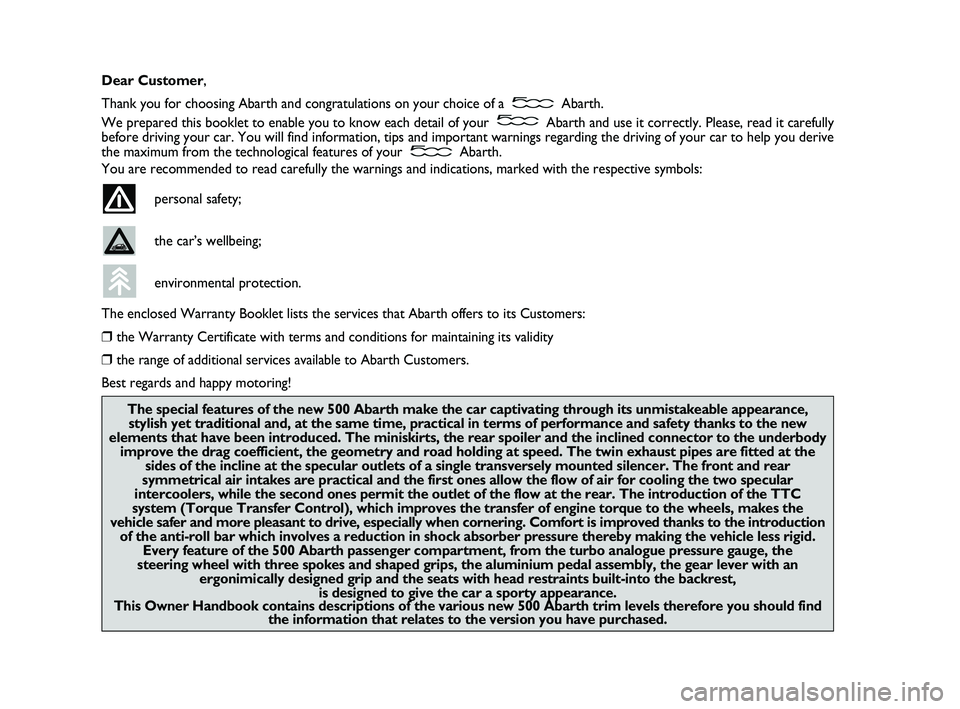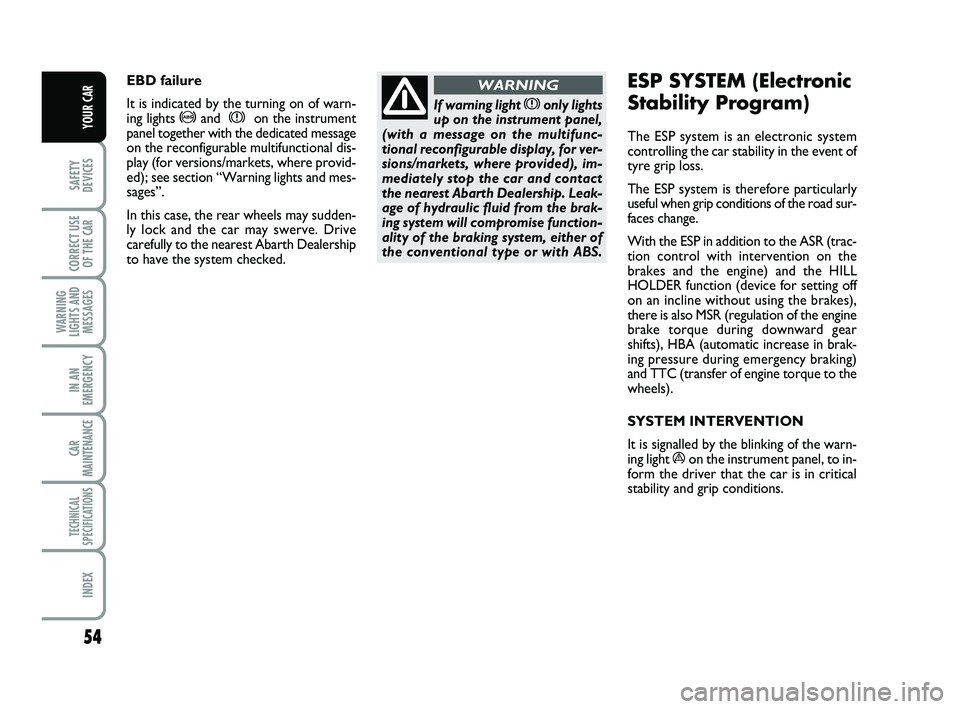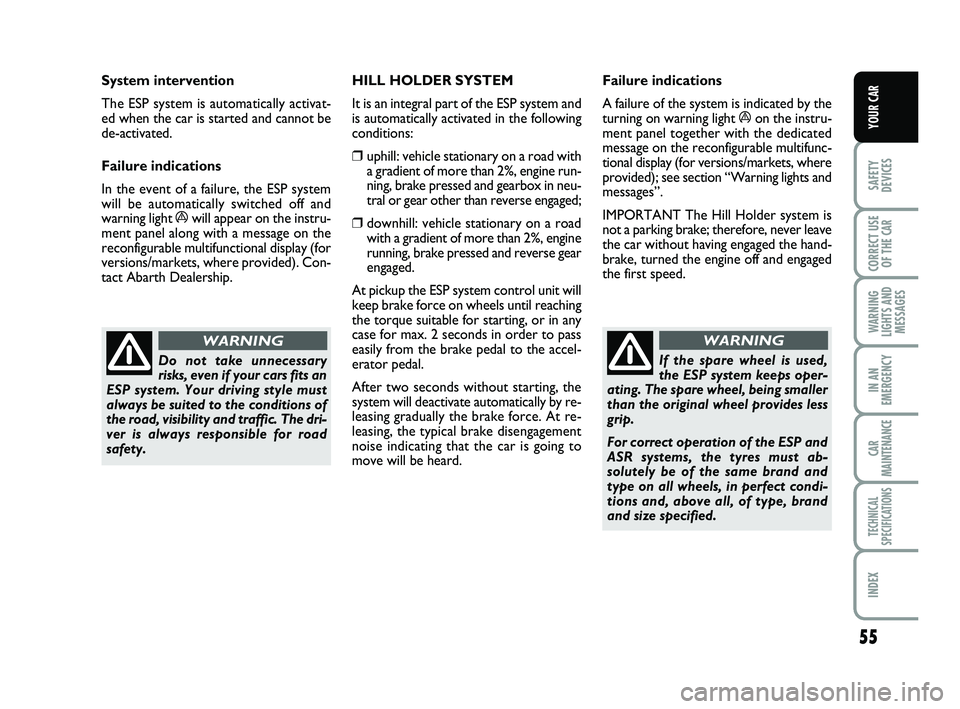wheel torque Abarth 500 2010 Owner handbook (in English)
[x] Cancel search | Manufacturer: ABARTH, Model Year: 2010, Model line: 500, Model: Abarth 500 2010Pages: 170, PDF Size: 3.04 MB
Page 2 of 170

Dear Customer,
Thank you for choosing Abarth and congratulations on your choice of a Abarth.
We prepared this booklet to enable you to know each detail of your Abarth and use it correctly. Please, read it carefully
before driving your car. You will find information, tips and important warnings regarding the driving of your car to help you derive
the maximum from the technological features of your Abarth.
You are recommended to read carefully the warnings and indications, marked with the respective symbols:
personal safety;
the car’s wellbeing;
environmental protection.
The enclosed Warranty Booklet lists the services that Abarth offers to its Customers:
❒the Warranty Certificate with terms and conditions for maintaining its validity
❒the range of additional services available to Abarth Customers.
Best regards and happy motoring!
The special features of the new 500 Abarth make the car captivating through its unmistakeable appearance,
stylish yet traditional and, at the same time, practical in terms of performance and safety thanks to the new
elements that have been introduced. The miniskirts, the rear spoiler and the inclined connector to the underbody
improve the drag coefficient, the geometry and road holding at speed. The twin exhaust pipes are fitted at the
sides of the incline at the specular outlets of a single transversely mounted silencer. The front and rear
symmetrical air intakes are practical and the first ones allow the flow of air for cooling the two specular
intercoolers, while the second ones permit the outlet of the flow at the rear. The introduction of the TTC
system (Torque Transfer Control), which improves the transfer of engine torque to the wheels, makes the
vehicle safer and more pleasant to drive, especially when cornering. Comfort is improved thanks to the introduction
of the anti-roll bar which involves a reduction in shock absorber pressure thereby making the vehicle less rigid.
Every feature of the 500 Abarth passenger compartment, from the turbo analogue pressure gauge, the
steering wheel with three spokes and shaped grips, the aluminium pedal assembly, the gear lever with an
ergonimically designed grip and the seats with head restraints built-into the backrest,
is designed to give the car a sporty appearance.
This Owner Handbook contains descriptions of the various new 500 Abarth trim levels therefore you should find
the information that relates to the version you have purchased.
001-022 ABARTH 500 GB 29-04-2009 9:40 Pagina 1
Page 38 of 170

37
SAFETY
DEVICES
CORRECT USE
OF THE
CAR
WARNING
LIGHTS AND
MESSAGES
IN AN
EMERGENCY
CAR
MAINTENANCE
TECHNICAL
SPECIFICATIONS
INDEX
YOUR CAR
CONTROLS
SPORT FUNCTION CONTROL
fig. 33
When the SPORT button A-fig. 33is
pressed the sports driving setting is turned
on featuring more responsiveness during
acceleration, an increase in drive torque
and more precise steering with greater ef-
fort required on the steering wheel.
When the function is active, the message
SPORT is displayed on the instrument
panel. Press again the button to deactivate
the function and return to the standard
driving mode.
IMPORTANT Pressing SPORT, the func-
tion is active after about 5 seconds.
IMPORTANT When in SPORT mode, ac-
celeration may be abrupt, This is typical of
this mode.FRONT/REAR FOG LIGHTS
(where provided) fig. 33
To turn on the front/rear fog lights, use
the button Cas follows:
1° Pressure: front fog lights on
2° Pressure: rear fog lights on
3° Pressure: lights off
When the front fog lights are on, the
warning light
5turns on on the instru-
ment panel; when the rear fog lights are
on, the warning light
4turns on on the
instrument panel.
Front fog lights are turned on with low
beams on.
CD
MENU
FM ASAM 1 2 3 4 5 6 AUD
MP3 RND RPT TPM CD-IN EQ
LOUD AF LOC PTY TP TA RMB PBCD
BCA
F0S033Abfig. 33
HAZARD LIGHTS fig. 33
They turn on pressing the button B, re-
gardless of the position of the ignition key.
When the function is active, warning lights
Îand ¥on the panel blink.
To switch off, press again the button B.
The use of hazard lights is governed by the
Highway Code of the country you are in.
Keep to the rules.
Emergency braking
In the event of emergency braking the
emergency lights automatically turn on and
at the same time the lights
Îend ¥turn
on on the dashboard.
The function automatically turns off when
the emergency braking stops.
This function complies with the current ap-
plicable laws.
023-045 ABARTH 500 GB 29-04-2009 9:41 Pagina 37
Page 55 of 170

54
SAFETY
DEVICES
CORRECT USE
OF THE
CAR
WARNING
LIGHTS AND
MESSAGES
IN AN
EMERGENCY
CAR
MAINTENANCE
TECHNICAL
SPECIFICATIONS
INDEX
YOUR CAR
If warning light xonly lights
up on the instrument panel,
(with a message on the multifunc-
tional reconfigurable display, for ver-
sions/markets, where provided), im-
mediately stop the car and contact
the nearest Abarth Dealership. Leak-
age of hydraulic fluid from the brak-
ing system will compromise function-
ality of the braking system, either of
the conventional type or with ABS.
WARNINGESP SYSTEM (Electronic
Stability Program)
The ESP system is an electronic system
controlling the car stability in the event of
tyre grip loss.
The ESP system is therefore particularly
useful when grip conditions of the road sur-
faces change.
With the ESP in addition to the ASR (trac-
tion control with intervention on the
brakes and the engine) and the HILL
HOLDER function (device for setting off
on an incline without using the brakes),
there is also MSR (regulation of the engine
brake torque during downward gear
shifts), HBA (automatic increase in brak-
ing pressure during emergency braking)
and TTC (transfer of engine torque to the
wheels).
SYSTEM INTERVENTION
It is signalled by the blinking of the warn-
ing light
áon the instrument panel, to in-
form the driver that the car is in critical
stability and grip conditions. EBD failure
It is indicated by the turning on of warn-
ing lights
>and xon the instrument
panel together with the dedicated message
on the reconfigurable multifunctional dis-
play (for versions/markets, where provid-
ed); see section “Warning lights and mes-
sages”.
In this case, the rear wheels may sudden-
ly lock and the car may swerve. Drive
carefully to the nearest Abarth Dealership
to have the system checked.
046-062 ABARTH 500 GB 29-04-2009 9:41 Pagina 54
Page 56 of 170

55
SAFETY
DEVICES
CORRECT USE
OF THE
CAR
WARNING
LIGHTS AND
MESSAGES
IN AN
EMERGENCY
CAR
MAINTENANCE
TECHNICAL
SPECIFICATIONS
INDEX
YOUR CAR
Do not take unnecessary
risks, even if your cars fits an
ESP system. Your driving style must
always be suited to the conditions of
the road, visibility and traffic. The dri-
ver is always responsible for road
safety.
WARNING
System intervention
The ESP system is automatically activat-
ed when the car is started and cannot be
de-activated.
Failure indications
In the event of a failure, the ESP system
will be automatically switched off and
warning light
áwill appear on the instru-
ment panel along with a message on the
reconfigurable multifunctional display (for
versions/markets, where provided). Con-
tact Abarth Dealership.HILL HOLDER SYSTEM
It is an integral part of the ESP system and
is automatically activated in the following
conditions:
❒uphill: vehicle stationary on a road with
a gradient of more than 2%, engine run-
ning, brake pressed and gearbox in neu-
tral or gear other than reverse engaged;
❒downhill: vehicle stationary on a road
with a gradient of more than 2%, engine
running, brake pressed and reverse gear
engaged.
At pickup the ESP system control unit will
keep brake force on wheels until reaching
the torque suitable for starting, or in any
case for max. 2 seconds in order to pass
easily from the brake pedal to the accel-
erator pedal.
After two seconds without starting, the
system will deactivate automatically by re-
leasing gradually the brake force. At re-
leasing, the typical brake disengagement
noise indicating that the car is going to
move will be heard.Failure indications
A failure of the system is indicated by the
turning on warning light áon the instru-
ment panel together with the dedicated
message on the reconfigurable multifunc-
tional display (for versions/markets, where
provided); see section “Warning lights and
messages”.
IMPORTANT The Hill Holder system is
not a parking brake; therefore, never leave
the car without having engaged the hand-
brake, turned the engine off and engaged
the first speed.
If the spare wheel is used,
the ESP system keeps oper-
ating. The spare wheel, being smaller
than the original wheel provides less
grip.
For correct operation of the ESP and
ASR systems, the tyres must ab-
solutely be of the same brand and
type on all wheels, in perfect condi-
tions and, above all, of type, brand
and size specified.
WARNING
046-062 ABARTH 500 GB 29-04-2009 9:41 Pagina 55
Page 57 of 170

56
SAFETY
DEVICES
CORRECT USE
OF THE
CAR
WARNING
LIGHTS AND
MESSAGES
IN AN
EMERGENCY
CAR
MAINTENANCE
TECHNICAL
SPECIFICATIONS
INDEX
YOUR CAR
MSR system
(engine braking torque control)
It is an integral part of the ASR system that
in case of sudden gear downshifting, cuts
in providing torque to the engine thus pre-
venting excessive driving wheel drive that,
specially in poor grip conditions, can lead
to loss of stability.TTC SYSTEM
(Torque Transfer Control)
It is an integral part of the ESP system.
This system improves the transfer of dri-
ve torque to the wheels, guaranteeing
safer and more sporty driving, especially
when cornering, far more able to prevent
understeer.
The system is turned on by pressing the
button in the dashboard C-Fig. 58. The
LED in the TTC button is lit up when it
is on.
It is turned off by pressing the button again
or when the vehicle is switched off (igni-
tion key in STOP position). ASR SYSTEM
(Antislip Regulation)
It’s integral to the ESP system and auto-
matically intervenes in case of slip of one
or both drive wheels, helping the driver
to control the car.
The action of the ASR is particularly help-
ful in the following circumstances:
❒slipping of the inner wheel due to the
effect of dynamic load changes or ex-
cessive acceleration;
❒too much power transmitted to the
wheels also in relation to the conditions
of the road surface;
❒acceleration on slippery, snowy or
frozen surfaces;
❒in the case of loss of grip on a wet sur-
face (acquaplaning).
fig. 58
TTC
C
F0S058Ab
046-062 ABARTH 500 GB 29-04-2009 9:41 Pagina 56